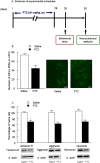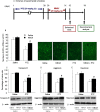AMPA Receptor Antagonist NBQX Decreased Seizures by Normalization of Perineuronal Nets
- PMID: 27880801
- PMCID: PMC5120819
- DOI: 10.1371/journal.pone.0166672
AMPA Receptor Antagonist NBQX Decreased Seizures by Normalization of Perineuronal Nets
Abstract
Epilepsy is a serious brain disorder with diverse seizure types and epileptic syndromes. AMPA receptor antagonist 2,3-dihydroxy-6-nitro-7-sulfamoyl-benzoquinoxaline-2,3-dione (NBQX) attenuates spontaneous recurrent seizures in rats. However, the anti-epileptic effect of NBQX in chronic epilepsy model is poorly understood. Perineuronal nets (PNNs), specialized extracellular matrix structures, surround parvalbumin-positive inhibitory interneurons, and play a critical role in neuronal cell development and synaptic plasticity. Here, we focused on the potential involvement of PNNs in the treatment of epilepsy by NBQX. Rats were intraperitoneally (i.p.) injected with pentylenetetrazole (PTZ, 50 mg/kg) for 28 consecutive days to establish chronic epilepsy models. Subsequently, NBQX (20 mg/kg, i.p.) was injected for 3 days for the observation of behavioral measurements of epilepsy. The Wisteria floribundi agglutinin (WFA)-labeled PNNs were measured by immunohistochemical staining to evaluate the PNNs. The levels of three components of PNNs such as tenascin-R, aggrecan and neurocan were assayed by Western blot assay. The results showed that there are reduction of PNNs and decrease of tenascin-R, aggrecan and neurocan in the medial prefrontal cortex (mPFC) in the rats injected with PTZ. However, NBQX treatment normalized PNNs, tenascin-R, aggrecan and neurocan levels. NBQX was sufficient to decrease seizures through increasing the latency to seizures, decrease the duration of seizure onset, and reduce the scores for the severity of seizures. Furthermore, the degradation of mPFC PNNs by chondroitinase ABC (ChABC) exacerbated seizures in PTZ-treated rats. Finally, the anti-epileptic effect of NBQX was reversed by pretreatment with ChABC into mPFC. These findings revealed that PNNs degradation in mPFC is involved in the pathophysiology of epilepsy and enhancement of PNNs may be effective for the treatment of epilepsy.
Conflict of interest statement
The authors have declared that no competing interests exist.
Figures



Similar articles
-
ChABC infusions into medial prefrontal cortex, but not posterior parietal cortex, improve the performance of rats tested on a novel, challenging delay in the touchscreen TUNL task.Learn Mem. 2020 May 15;27(6):222-235. doi: 10.1101/lm.050245.119. Print 2020 Jun. Learn Mem. 2020. PMID: 32414940 Free PMC article.
-
The AMPA receptor antagonist NBQX exerts anti-seizure but not antiepileptogenic effects in the intrahippocampal kainate mouse model of mesial temporal lobe epilepsy.Neuropharmacology. 2015 Aug;95:234-42. doi: 10.1016/j.neuropharm.2015.03.014. Epub 2015 Mar 31. Neuropharmacology. 2015. PMID: 25839899
-
The chemorepulsive axon guidance protein semaphorin3A is a constituent of perineuronal nets in the adult rodent brain.Mol Cell Neurosci. 2013 Sep;56:186-200. doi: 10.1016/j.mcn.2013.04.009. Epub 2013 May 9. Mol Cell Neurosci. 2013. PMID: 23665579
-
Perineuronal net, CSPG receptor and their regulation of neural plasticity.Sheng Li Xue Bao. 2014 Aug 25;66(4):387-97. Sheng Li Xue Bao. 2014. PMID: 25131780 Review.
-
Regulation of the E/I-balance by the neural matrisome.Front Mol Neurosci. 2023 Apr 18;16:1102334. doi: 10.3389/fnmol.2023.1102334. eCollection 2023. Front Mol Neurosci. 2023. PMID: 37143468 Free PMC article. Review.
Cited by
-
Socrates: A Novel N-Ethyl-N-nitrosourea-Induced Mouse Mutant with Audiogenic Epilepsy.Int J Mol Sci. 2023 Dec 4;24(23):17104. doi: 10.3390/ijms242317104. Int J Mol Sci. 2023. PMID: 38069426 Free PMC article.
-
Interactions between astrocytes and extracellular matrix structures contribute to neuroinflammation-associated epilepsy pathology.Front Mol Med. 2023 Jun 14;3:1198021. doi: 10.3389/fmmed.2023.1198021. eCollection 2023. Front Mol Med. 2023. PMID: 39086689 Free PMC article. Review.
References
-
- Berg AT, Berkovic SF, Brodie MJ, Buchhalter J, Cross JH, van Emde Boas W, et al. Revised terminology and concepts for organization of seizures and epilepsies: report of the ILAE Commission on Classification and Terminology, 2005–2009. Epilepsia. 2010;51 (4): 676–685. 10.1111/j.1528-1167.2010.02522.x - DOI - PubMed
-
- Collingridge GL, Lester RA. Excitatory amino acid receptors in the vertebrate central nervous system. Pharmacol Rev. 1989;41 (2): 143–210. - PubMed
MeSH terms
Substances
LinkOut - more resources
Full Text Sources
Other Literature Sources
Medical

